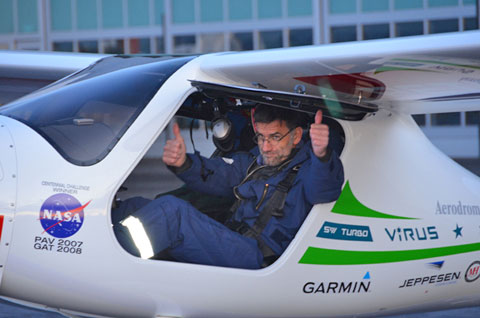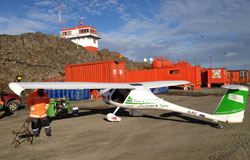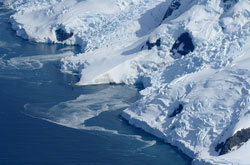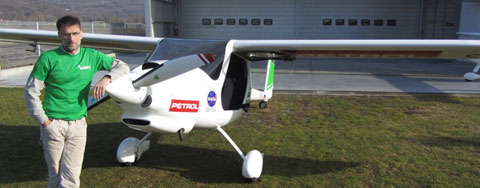Flying the Pacific on 93 gallons of fuel
Pilot to circumnavigate world in Pipistrel motor glider

Matevž Lenarčič completed the longest over-water leg of his around-the-world journey on Feb. 22, landing on Easter Island in the Pacific Ocean after more than 15 hours in the air, crossing 1,984 nautical miles of trackless ocean in a single-engine motor glider.
Launched Jan. 8 from his native Slovenia, Lenarčič is piloting a specially modified Pipistrel. The Virus SW914 is powered by a turbocharged Rotax engine that will allow Lenarčič to reach altitudes of 30,000 feet msl—high enough to fly over the top of Mount Everest.
On Feb. 16, Lenarčič became the first Pipistrel pilot to land on Antarctica, landing at Teniente R. Marsh Airport at the northern edge of the icy continent.
“Some delay due (to) changing flight plan from VFR into IFR got me out over Beagle channel quite late,” Lenarčič wrote in a blog post. “First part in between cloud layers avoiding ice was cold, but after I flew into the sun, life became more optimistic. Somewhere in the middle of Drake Passage, Domen [Domen Grauf, a member of the support team] sent me metar for Marambio, which was in fog, so soon I decided to fly into my alternative Chilean military base Marsh Martin.”
Wary of being trapped by the legendary Antarctic weather, Lenarčič hustled back to Chile and departed Feb. 21 for the longest water crossing of the voyage, carrying just 93 gallons of fuel for the journey to Easter Island.
 Matevž Lenarčič refueled in Antarctica after diverting to the Teniente R. Marsh Airport.
Matevž Lenarčič refueled in Antarctica after diverting to the Teniente R. Marsh Airport.
Along with proving the Pipistrel’s unmatched endurance, Lenarčič, a photographer, is on a mission to document the world’s water, offering views from above that he hopes will inspire ecological consciousness.
“Only people with a sense of the world are able to protect it,” reads the GreenLight WorldFlight mission statement. “Images will show places with plenty of clean drinking water and places without a single drop. We are going to show very different faces of water and warn the world that lack of water brings even more tension to the society than oil trade.”
The Pipistrel is also equipped with carbon sensors for atmospheric research.
While a host of manufacturers and technical specialists are supporting the mission, Lenarčič is very much alone during the long ocean crossings. Pipistrel engineer Tine Tomažič said there will be no immediate rescue available if something goes wrong.
 Matevž Lenarčič posted several photos of Antarctica on the GreenLight WorldFlight website.
Matevž Lenarčič posted several photos of Antarctica on the GreenLight WorldFlight website.
“No special resources were deployed—Matevž flies unassisted,” Tomažič wrote in an email to AOPA Online. “In case of emergency, regular SAR teams would respond.”
While fitted with a turbocharger, Lenarčič is flying in a nonpressurized cabin, relying on a “very advanced oxygen system” designed by Mountain High Oxygen Systems for the high-altitude portions of the circumnavigation. (Most of the trip is being made around 11,500 feet msl.) A dual-stage cabin heating system helps keep the pilot from freezing at Everest elevations.
“In addition, Matevž wears a special insulated suit, courtesy of Josef Stefan Institute, Ljubljana, Slovenia,” Tomažič wrote.

The Pipistrel is equipped with VHF and HF radios, and a satellite telephone and data link that allows Web users to track Lenarčič’s progress in real time.
Lenarčič, a veteran long-distance pilot who completed his first circumnavigation in 2004, is a member of the supervisory board of AOPA Slovenia, and a member of AOPA. He has logged more than 3,000 hours and holds a private pilot certificate with an instrument rating. If the itinerary holds, he will return to Slovenia on March 29.



